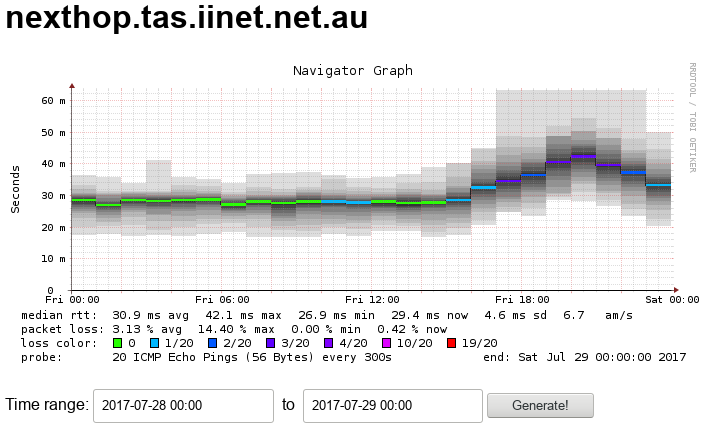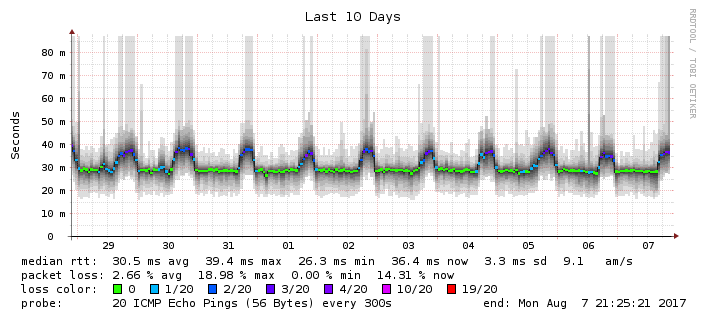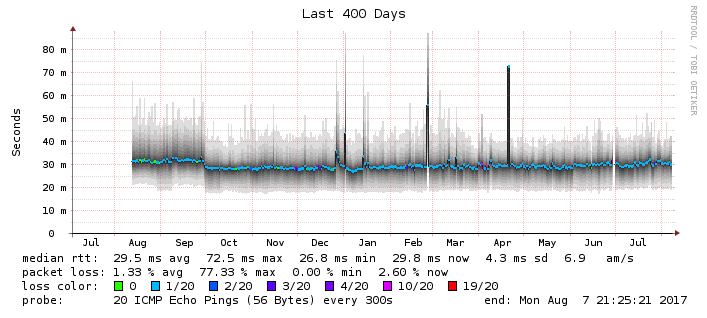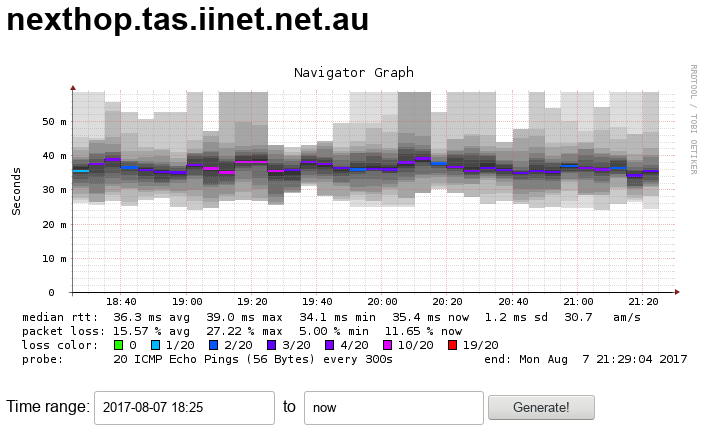I have a laptop and a desktop system (as well as a bunch of other crap, but let’s ignore that for a moment). Both laptop and desktop are running openSUSE Tumbleweed. I’m usually in front of my desktop, with dual screens, a nice keyboard and trackball, and the laptop is sitting with the lid closed tucked away under the desk. Importantly, the laptop is where my mail client lives. When I’m at my desk, I ssh from desktop to laptop with X forwarding turned on, then fire up Thunderbird, and it appears on my desktop screen. When I go travelling, I take the laptop with me, and I’ve still got my same email client, same settings, same local folders. Easy. Those of you considering heckling me for not using $any_other_mail_client and/or $any_other_environment, please save it for later.
Yesterday I had an odd problem. A new desktop system arrived, so I installed Tumbleweed, eventually ssh’d to my Laptop, started Thunderbird, and…
# thunderbird
…nothing happened. There’s usually a little bit of junk on the console at that point, and the Thunderbird window should have appeared on my desktop screen. But it didn’t. strace showed it stuck in a loop, waiting for something:
wait4(22167, 0x7ffdfc669be4, 0, NULL) = ? ERESTARTSYS (To be restarted if SA_RESTART is set)
--- SIGVTALRM {si_signo=SIGVTALRM, si_code=SI_TKILL, si_pid=22164, si_uid=1000} ---
rt_sigreturn({mask=[]}) = -1 EINTR (Interrupted system call)
wait4(22167, 0x7ffdfc669be4, 0, NULL) = ? ERESTARTSYS (To be restarted if SA_RESTART is set)
--- SIGVTALRM {si_signo=SIGVTALRM, si_code=SI_TKILL, si_pid=22164, si_uid=1000} ---
rt_sigreturn({mask=[]}) = -1 EINTR (Interrupted system call)
wait4(22167, 0x7ffdfc669be4, 0, NULL) = ? ERESTARTSYS (To be restarted if SA_RESTART is set)
--- SIGVTALRM {si_signo=SIGVTALRM, si_code=SI_TKILL, si_pid=22164, si_uid=1000} ---
rt_sigreturn({mask=[]}) = -1 EINTR (Interrupted system call)
After an assortment of random dead ends (ancient and useless bug reports about Thunderbird and Firefox failing to run over remote X sessions), I figured I may as well attach a debugger to see if I could get any more information:
# gdb -p 22167
GNU gdb (GDB; openSUSE Tumbleweed) 7.11
[...]
Attaching to process 22167
Reading symbols from /usr/lib64/thunderbird/thunderbird-bin...
[...]
0x00007f2e95331a1d in poll () from /lib64/libc.so.6
(gdb) break
Breakpoint 1 at 0x7f2e95331a1d
(gdb) bt
#0 0x00007f2e95331a1d in poll () from /lib64/libc.so.6
#1 0x00007f2e8730b410 in ?? () from /usr/lib64/libxcb.so.1
#2 0x00007f2e8730cecf in ?? () from /usr/lib64/libxcb.so.1
#3 0x00007f2e8730cfe2 in xcb_wait_for_reply () from /usr/lib64/libxcb.so.1
#4 0x00007f2e86ecc845 in ?? () from /usr/lib64/libGL.so.1
#5 0x00007f2e86ec74b8 in ?? () from /usr/lib64/libGL.so.1
#6 0x00007f2e86e9a2a9 in ?? () from /usr/lib64/libGL.so.1
#7 0x00007f2e86e9654b in ?? () from /usr/lib64/libGL.so.1
#8 0x00007f2e86e966b3 in glXChooseVisual () from /usr/lib64/libGL.so.1
#9 0x00007f2e90fa0d6f in glxtest () at /usr/src/debug/thunderbird/mozilla/toolkit/xre/glxtest.cpp:230
#10 0x00007f2e90fa1003 in fire_glxtest_process () at /usr/src/debug/thunderbird/mozilla/toolkit/xre/glxtest.cpp:333
#11 0x00007f2e90f9b4cd in XREMain::XRE_mainInit (this=this@entry=0x7ffdfc66c448, aExitFlag=aExitFlag@entry=0x7ffdfc66c3ef) at /usr/src/debug/thunderbird/mozilla/toolkit/xre/nsAppRunner.cpp:3134
#12 0x00007f2e90f9ee27 in XREMain::XRE_main (this=this@entry=0x7ffdfc66c448, argc=argc@entry=1, argv=argv@entry=0x7ffdfc66d958, aAppData=aAppData@entry=0x7ffdfc66c648)
at /usr/src/debug/thunderbird/mozilla/toolkit/xre/nsAppRunner.cpp:4362
#13 0x00007f2e90f9f0f2 in XRE_main (argc=1, argv=0x7ffdfc66d958, aAppData=0x7ffdfc66c648, aFlags=) at /usr/src/debug/thunderbird/mozilla/toolkit/xre/nsAppRunner.cpp:4484
#14 0x00000000004054c8 in do_main (argc=argc@entry=1, argv=argv@entry=0x7ffdfc66d958, xreDirectory=0x7f2e9504a9c0) at /usr/src/debug/thunderbird/mail/app/nsMailApp.cpp:195
#15 0x0000000000404c4a in main (argc=1, argv=0x7ffdfc66d958) at /usr/src/debug/thunderbird/mail/app/nsMailApp.cpp:332
(gdb) continue
[Inferior 1 (process 22167) exited with code 01]
OK, so it’s libGL that’s waiting for something. Why is my mail client trying to do stuff with OpenGL?
Hang on! When I told gdb to continue, suddenly Thunderbird appeared, running properly, on my desktop display. WTF?
As far as I can tell, the problem is that my new desktop system has an NVIDIA GPU (nouveau drivers, BTW), and my laptop and previous desktop system both have Intel GPUs. Something about ssh’ing from the desktop with the NVIDIA GPU to the laptop with the Intel GPU, causes Thunderbird (and, indeed, any GL app — I also tried glxinfo and glxgears) to just wedge up completely. Whereas if I do the reverse (ssh from Intel GPU laptop to NVIDIA GPU desktop) and run GL apps, it works fine.
After some more Googling, I discovered I can make Thunderbird work properly over remote X like this:
# LIBGL_ALWAYS_INDIRECT=1 thunderbird
That will apparently cause glXCreateContext to return BadValue, which is enough to kick Thunderbird along. LIBGL_ALWAYS_SOFTWARE=1 works equally well to enable Thunderbird to function, while presumably still allowing it to use OpenGL if it really needs to for something (proof: LIBGL_ALWAYS_INDIRECT=1 glxgears fails, LIBGL_ALWAY_SOFTWARE=1 glxgears gives me spinning gears).
I checked Firefox too, and it of course has the same remote X problem, and the same solution.






 Almost every time I fly, it seems like I get pulled aside for the random explosives trace detection test. I always assumed it was because I usually look like a crazy mountain man (see photo). But, if you google around for “airport random explosives test”, you’ll find forum posts from security staff assuring everyone they’re not doing profiling, and even a helpful FAQ from Newcastle Airport (“
Almost every time I fly, it seems like I get pulled aside for the random explosives trace detection test. I always assumed it was because I usually look like a crazy mountain man (see photo). But, if you google around for “airport random explosives test”, you’ll find forum posts from security staff assuring everyone they’re not doing profiling, and even a helpful FAQ from Newcastle Airport (“

